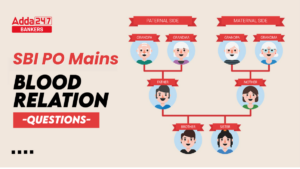Table of Contents
The reasoning segment holds significant importance in the SBI PO Exam, being crucial in both the preliminary and mains. A strong grasp of this section is vital for aspiring SBI PO candidates aiming to secure a position within the State Bank of India. It assesses candidates’ analytical skills and their capacity to solve problems within specified time constraints. In this article, we explore the reasoning questions of the SBI PO Bank Exam, providing an in-depth understanding of SBI PO reasoning to aid in effective preparation.
Reasoning Questions in SBI PO Exam
Before diving into the Reasoning questions, it’s crucial to acquaint ourselves with the diverse question structures organized by topics for the SBI PO 2024 Bank Exam. The Reasoning segment of the SBI PO test comprises a variety of question styles carefully designed to assess candidates’ logical and analytical abilities. Some common question formats include:
| Question Format | |
| Topic | Question Type |
| Seating Arrangement | Arranging individuals or objects in an order based on the given conditions, such as circular arrangement, linear arrangement, or rectangular arrangement. |
| Puzzles | Arranging elements or variables based on the given conditions to arrive at a logical solution. |
| Syllogism | Drawing logical conclusions from the statements provided using the set of rules. |
| Blood Relation | Determining the relationship between different individuals based on the information given. |
| Coding-Decoding | Deciphering the coded messages or patterns from the underlying logic. |
| Input-Output | Understand the logic behind a series of inputs and outputs to answer questions based on the pattern. |
| Direction Sense | Interpreting the directions and navigating through a given scenario or finding out the distance. |
| Logical Reasoning | Evaluate arguments, draw conclusions, and identify patterns in the given set of information. |
| Inequalities | Questions involving comparing quantities and determining the relationship and comparison between them. |
| Logical Reasoning | Logical reasoning questions involve deductive reasoning, pattern recognition, and drawing logical conclusions. |
Logical Reasoning for SBI PO
Logical Reasoning also forms important part of Reasoning Section in mains exam of SBI PO. Some of the important topics under logical reasoning are mentioned in the table below.
| Logical Reasoning | |
| Topics | Description |
| Statement & Conclusion | This topic involves analyzing a set of statements and determining the logical conclusion or inference that can be drawn from them, based on the information provided. |
| Statement & Assumption | In this topic, candidates evaluate whether the given statements imply certain assumptions, and assess the validity of those assumptions in relation to the context provided. |
| Cause & Effect | Cause and effect questions require candidates to identify the relationship between events or phenomena, determining which is the cause and which is the effect based on the given information. |
| Statement & Inference | This topic involves analyzing statements to derive logical inferences or conclusions that can be reasonably drawn from them, considering implicit meanings or implications beyond the explicit information provided. |
Weightage of Reasoning in SBI PO Exam
The importance of reasoning questions in the SBI PO examination cannot be overstated, as they constitute a significant portion of the total marks. Achieving mastery in this section is essential for candidates aiming to perform well in the exam. Reasoning questions come in various formats, such as puzzles, seating arrangements, coding-decoding, syllogism, and logical reasoning. Each type of question requires distinct problem-solving approaches, evaluating the candidate’s analytical abilities and logical reasoning skills. Recognizing its significance, candidates often devote considerable time to practicing reasoning questions to improve their proficiency and enhance their chances of success in the SBI PO examination.
| Weightage of Reasoning in SBI PO Exam | ||
| Exam | No. of Questions | Total Marks |
| Prelims | 35 | 35 |
| Mains | 40 | 50 |
Tips and Tricks to Solve SBI PO Reasoning Questions
For many candidates, excelling in the Reasoning Ability section offers an opportunity to achieve high scores, provided they have a solid understanding of the fundamental concepts underlying the questions in this section. Mastering SBI PO reasoning questions demands strategic approaches. Here are some guidelines to effectively tackle them:
Grasp Question Types: Get familiar with different types of reasoning questions like puzzles, syllogism, coding-decoding, and seating arrangement. Recognizing question patterns aids in devising suitable solving techniques.
Regular Practice: Consistent practice is crucial for improving reasoning skills. Solve a variety of reasoning questions from past SBI Clerk papers and practice sets to enhance problem-solving abilities and speed.
Enhance Logical Thinking: Reasoning questions often require logical deduction and analysis. Strengthen logical thinking by regularly solving puzzles, riddles, and brain teasers. Break down complex problems into smaller, manageable parts for more efficient solutions.
Daily Online Quizzes: Regularly attempt Reasoning Ability questions through mock tests and quizzes on platforms like the Adda247 app. This significantly reinforces concepts and sharpens problem-solving skills.
Manage Time: Wisely allocate time to each question during practice sessions. Set time limits for different question types to improve speed and accuracy. Initially skip difficult questions and return to them later if time allows.
Utilize Elimination Techniques: When encountering multiple-choice questions, eliminate obviously incorrect options to narrow down choices. This increases the likelihood of selecting the correct answer, especially when unsure about the solution.
Incorporating these strategies into your preparation regimen empowers you to confidently tackle SBI PO reasoning questions, thus maximizing your chances of success in the exam.
SBI PO Reasoning Questions with Solutions
Directions (1-5): Study the following information carefully and answer the questions given below:
In a certain code language:
‘Loss Profit Strong’ is written as ‘os if gn’,
‘Profit Chart Strong’ is written as ‘rt gn if’,
‘Boat Profit Cost’ is written as ‘if ot so’
‘Strong Chart Profit’ is written as ‘gn rt if’.
Q1. What is the code for ‘Chart’ in the given code language?
(a) gn
(b) if
(c) ot
(d) rt
(e) None of these
Q2. If ‘Boat’ is coded as ‘so’. What is the code for ‘article cost’ in the given code language?
(a) le if
(b) ot le
(c) so gn
(d) if rt
(e) None of these
Q3. What is the code for ‘Profit’ in the given code language?
(a) if
(b) gn
(c) ot
(d) rt
(e) Can’t be determined
Q4. What may be the code for ‘Strong’ in the given code language?
(a) if
(b) rt
(c) gn
(d) so
(e) None of these
Q5. What may be the code for ‘Loss Chart cost’?
(a) so gn ot
(b) if gn ot
(c) os gn ot
(d) so gn if
(e) None of these
Directions (6-10): In the question below, there are some conclusions followed by four set of some statements in the options. You have to take the given statements to be true even if they seem to be at variance from the commonly known facts and then decide which of the given statements are true disregarding the commonly known facts.
Q6. Conclusions: Few Bags are not Levi’s. Some Brands are Belts.
(a) Only a few Bags are Belts. Only Belts are Levi’s. All Bags are Brands.
(b) Only Levi’s are Belts. Some Levi’s are Brands. All Bags are Brands
(c) Only a few Brands are Levi’s. All Bags are Belts. Some Belts are Levi’s
(d) All Bags are Belts. All Belts are Brands. All Brands are Levi’s
(e) None of the above
Q7. Conclusions: Some Non-metals are Organic. All Metals can be Non-metals
(a) Some Metals are Organic, All non-metals are Metalloids. No Organic are Metalloids
(b) Some Metalloids are Organic. No Metalloids are Metals. All non-metals are Metals.
(c) All Metals are Organic. Some Non-metals are Metalloids. All Metalloids are Organic.
(d) Only a few Non-metals are Metalloids. All Organic are Metals, Few Organic are Metalloids.
(e) Both option (b) and option (d) are correct.
Q8. Conclusions: No rich is poor. A few rule can be rent. Some river being rich is a possibility.
(a) All rich is rent. Some rent is poor. No poor is river. Only river is rule.
(b) Some rich is rent. Mostly rent is poor. All poor is river. No river is rule.
(c) All rich is rent. No rent is poor. No poor is river. All rivers is rule.
(d) No rich is rent. Some rent is poor. Only a few poor is river. Some river is rule.
(e) None of these
Q9. Conclusions: All Asus can never be Dell. All Dell can be HP. Some Lenovo are Asus.
(a) All Lenovo are ThinkPad. Some Dell are Lenovo All Lenovo are HP. No HP is Asus.
(b) All ThinkPad are HP. Few HP are Dell. All Asus are Lenovo. Some Lenovo are Dell.
(c) Only a few HP are Dell. All Dell are Lenovo. Some ThinkPad are Asus. All HP are Asus.
(d) Only Asus are Dell. Only a few Asus are HP. Some Lenovo are HP. No ThinkPad are HP.
(e) Both option (b) and option (d) are correct.
Q10. Conclusions: Some Guitar can never be Flute. Some Drum can be Violin. Every Violin can be Piano.
(a) Only Violin is Piano. Only a few Violin is Flute. Few Flute is Guitar. No Guitars Drum.
(b) Few Piano is Drum. Only a few Drum is Violin. Only a few Guitar is Flute. No Violin is Guitar.
(c) Only a few Flute is Violin. Only Flute is Drum. 50% Flute is Guitar. No Guitar is Piano.
(d) Few Drum is Flute. No Flute is Guitar. 100% Guitar is Violin. Only a few Piano in Violin.
(e) None of these
Direction (11-15): Study the following information carefully and answer the questions given below.
Eight boxes i.e., M, N, O, P, Q, R, S and T are placed one above the other. These boxes contain different dry fruits i.e., Almonds, Cashews, Raisins, Dates, Figs, Walnuts, Saffron and Apricots but not necessarily in the same order.
The box which contains Cashews is placed just above S which is not placed at bottommost position. Three boxes are placed between S and O. There are two boxes which are placed between O and T. Not more than one box is placed between T and M. Maximum one box is placed between O and M. Q is placed third above M and contains Dates. Three boxes are placed between Q and P. One box is placed between P and S which contains Apricots. More than two boxes are placed between M and R. There are three boxes placed between the box which contains Apricots and the box which contains Saffron. One box is placed between the box which contains Saffron and the box which contains Figs. N does not contain Almonds and Walnuts. M does not contain Walnuts.
Q11. Which of the following box is placed at top?
(a) T
(b) Q
(c) P
(d) N
(e) O
Q12. Which of the following statement is true?
(a) O contains Cashews
(b) Two boxes are placed between N and S
(c) R contains Walnuts
(d) S is placed just above T
(e) None is true
Q13. Which of the following box is placed second above the box which contains Almonds?
(a) Q
(b) N
(c) M
(d) P
(e) S
Q14. How many boxes are placed between the box which contains Walnuts and N?
(a) One
(b) Two
(c) Four
(d) Five
(e) Six
Q15. What is the position of O with respect to N?
(a) Just below
(b) Second below
(c) Second above
(d) Third above
(e) None of the above
Q16. If it is possible to make a meaningful word from 2nd, 3rd, 5th and 6th letters of word “COMPREHENSIVE”, then which will be the 3rd letter of that meaningful word? If no such meaningful word is formed, then mark the answer as ‘Y’. If more than one meaningful word is formed, then mark the answer as ‘X’.
(a) Y
(b) O
(c) E
(d) R
(e) X
Q17. Which of the following letter will become the exact middle letter, if all the letters of the word “COPYRIGHT” are arranged in reverse alphabetical order from left to right?
(a) P
(b) H
(c) O
(d) R
(e) None of the above
Q18. If it is possible to make a meaningful word from 1st, 3rd, 4th and 6th letters of word “ANTIFLAME”, then which will be the 3rd letter of that meaningful word? If no such meaningful word is formed, then mark the answer as ‘Y’. If more than one meaningful word is formed, then mark the answer as ‘X’.
(a) Y
(b) T
(c) A
(d) I
(e) X
Q19. How many pairs of letters are there in the word “ORGANICS” which has as many letters between them in the word as they have in the alphabetical series (both in forward and backward direction)?
(a) One
(b) Two
(c) Three
(d) Four
(e) None of the above
Q20. How many pairs of letters are there in the word “PREMIUM” which has as many letters between them in the word as they have in the alphabetical series (both in forward and backward direction)?
(a) One
(b) Two
(c) Three
(d) Four
(e) None of the above
Direction (21-25): Study the following information and answer carefully.
A certain number of persons are standing in a row facing north. Q stands at one of the ends of the row. As many persons are standing between R and T as between S and R. Eight persons are standing between S and P. Only one person stands between Q and S. P is 3rd from one of the ends. L is 5th to the left of R. More than 6 persons are standing between Q and T. Not more than 5 persons are standing between P and L.
Q21. How many persons are standing to the right of L?
(a) 12
(b) 9
(c) 10
(d) 11
(e) None of these
Q22. If X is 4th right to T, then how many persons are standing between P and X?
(a)3
(b) 4
(c) 6
(d) 5
(e) None of these
Q23. How many total numbers of persons are standing in the row?
(a) 15
(b) 14
(c) 13
(d) 12
(e) None of these
Q24. How many persons are standing between P and R?
(a) Four
(b) Three
(c) Five
(d) Seven
(e) Six
Q25. If ‘O’ is third to the left of L, then what is the position of O with respect to P?
(a) Second to the right
(b) Immediate right
(c) Second to the left
(d) Third to the left
(e) Immediate left
Directions (26-30): In the following questions the symbol *, $, #, % and @ are used with the following meaning as illustrated below:
‘A $ B’ means ‘A is not smaller than B.’
‘A * B’ means ‘A is neither greater than nor equal to B.’
‘A # B’ means ‘A is neither smaller than nor equal to B.’
‘A % B’ means ‘A is not greater than B.’
‘A @ B’ means ‘A is neither greater than nor smaller than B.’
Now in each of the following questions assuming the statements to be true, find which of the three conclusions I, II and III given below them is/are definitely true and give answer accordingly.
Q26. Statements: S#J, J$D, D@K, K%Q
Conclusions: I. Q#D
II. Q@D
III. S#K
(a) Only I and II are true
(b) Only I is true
(c) Only II is true
(d) Only III is true
(e) None of the above
Q27. Statements: T%P, P$M, M@D, D*Q
Conclusions: I. D%P
II. Q#P
III. T*M
(a) None is true
(b) Only I is true
(c) Only II is true
(d) Only III is true
(e) Only I and III are true
Q28. Statements: M@C, C#N, C$R, R*K
Conclusions: I. K#C
II. R*N
III. M$R
(a) None is true
(b) Only I is true
(c) Only I and III are true
(d) Only III is true
(e) Only I and II are true
Q29. Statements: T#H, H@M, M*O, O$J
Conclusion: I. J*M
II. O#H
III. M*T
(a) None is true
(b) Only I is true
(c) Only II is true
(d) Only II and III are true
(e) Only I and II are true
Q30. Statements: P@S, S%Q, Q*T, T$R
Conclusion: I. S*T
II. P%T
III. S%R
(a) None is true
(b) Only I is true
(c) Only II is true
(d) Only III is true
(e) Only I and II are true.
Directions (31-35): Study the following arrangement carefully and answer the questions given below:
N 4 7 T U J K 3 % F @ © L N 5 P 1 8 U $ E 2 D C 6 # 9 Z Q 8 Y * M A
Q31. Which of the following is sixth to the left of the fifteenth from the left end of the given arrangement?
(a) 2
(b) #
(c) %
(d) $
(e) None of these
Q32. How many such numbers are there in the given arrangement each of which is immediately preceded by a consonant but not immediately followed by a letter?
(a) One
(b) None
(c) three
(d) Two
(e) Four
Q33. How many such symbols are there in the arrangement, each of which is immediately followed by a letter but not immediately preceded by a number?
(a) One
(b) Three
(c) None
(d) Two
(e) More than three
Q34. What should come in place of question mark (?) in the following series based on the above arrangement?
TU3 @©5 8U2 ?
(a) 69Q
(b) #Z8
(c) 6#Q
(d) #9Z
(e) None of these
Q35. Four of the following five are alike in a certain way based on their positions in the given arrangement and so from a group. Which is the one that does not belong to that group?
(a) DC6
(b) @©L
(c) 9ZQ
(d) 5P1
(e) #MA
Directions (36-40): Study the following information carefully to answer the given questions.
Ten persons of a family i.e., P, Q, R, S, T, U, V, W, X and Y sit around a rectangular table in such a way that three of them sit at each of the longer side of the table and faces towards the centre and two of them sit at each of the shorter side of the table and faces away from the centre. All the information is not necessarily in the same order.
P who is father of R sits third to the right of Q’s daughter-in-law. W sits at the immediate left of Q’s father-in-law who is married with V. P is the only child of V who sits opposite to the one who sits at the immediate left of R’s wife. X is son of U who is a female member. S is paternal aunt of X and sits second to the right of Q’s only sibling. W sits only with Y who is child of U. Y is not nephew of S. R has more than one child. W is not married and sits opposite to R. R’s spouse sits on the same side with R. P’s wife sits at the immediate left of Y sibling.
Q36. How T is related to the one who sits second to the left of Q?
(a) Sister
(b) Brother
(c) Father
(d) Grand father
(e) Grand mother
Q37. Four of the following are alike in a certain way so form a group, who among the following does not belong to that group?
(a) R
(b) X
(c) U
(d) P
(e) T
Q38. How many persons sit between S and V when counted from the right of V?
(a) One
(b) Two
(c) Five
(d) Three
(e) Four
Q39. Which of the following statement is not true?
(a) S, X and Q sits together on the same side of the table
(b) Q sits opposite to P
(c) Q sits at the immediate left of X
(d) T is father-in-law of Q
(e) S sits opposite to T
Q40. How many female members are there in the family?
(a) Can’t be determined
(b) Six
(c) Seven
(d) Five
(e) Four
Directions (41-43): Answer the questions based on the information given below.
Seven persons are sitting at some distance from each other. W is sitting 4m west to X. T is sitting 2m north to S, who is sitting 4m west to Q, who is sitting 1m north to V. W is sitting 2m north to Y. Y is sitting 8m west of T.
Q41. What is the direction of X with respect to Q?
(a) North-east
(b) South-east
(c) North
(d) North-west
(e) None of these
Q42. What is the shortest distance between W and V?
(a) 13m
(b) 15m
(c) 11m
(d) 9m
(e) 8m
Q43. What is the direction of S with respect to W?
(a) North-east
(b) South-east
(c) South-west
(d) North-west
(e) None of these
Directions (44-45): Answer the questions based on the information given below. In a certain code:
A & B means A is 9m west of B.
A % B means A is 4m south of B.
A * B means A is 7m north of B.
A @ B means A is 5m east of B.
Q44. In expression ‘M&N%A%C&O*P*Q’, then Q is in which direction with respect to C?
(a) North-east
(b) South-east
(c) South-west
(d) North-west
(e) None of these
Q45. In expression ‘P&R&T@S%Q*L*M’, what is shortest distance between P and L?
(a) √178m
(b) √176m
(c) √185m
(d) √204m
(e) None of these
Directions (46-50): Study the following arrangement carefully and answer the questions given below.
@ E K 4 F 7 B 5 R 1 © D A M 6 U J $ V Q # 2 P 3 % 9 H I W 8 *
Q46. Which of the following element is exactly in the middle of first vowel in this series from the left side and 5 in the above arrangement?
(a) 7
(b) F
(c) R
(d) 4
(e) None of these
Q47. How many such symbols are there in the above arrangement each of which is immediately preceded by a consonant but not immediately followed by a Vowel?
(a) None
(b) One
(c) Two
(d) Three
(e) More than three
Q48. Four of the following five are alike in a certain way based on their position in the above arrangement and so form a group. Which is the one that does not belong to that group?
(a) FB7
(b) 23P
(c) 9IH
(d) V2#
(e) 1D©
Q49. How many such symbols are there in the above arrangement each of which is immediately preceded by a number but not immediately followed by a consonant?
(a) None
(b) One
(c) Two
(d) Three
(e) More than three
Q50. How many such Vowel is there in the above arrangement each of which is immediately followed by a number but not immediately preceded by a symbol?
(a) None
(b) One
(c) Two
(d) Three
(e) More than three?
Answers:
| Answers | |||||||||
| 1. d | 6. a | 11. b | 16. d | 21. c | 26. e | 31. c | 36. d | 41. d | 46. b |
| 2. b | 7. c | 12. c | 17. c | 22. c | 27. b | 32. e | 37. c | 42. a | 47. c |
| 3. e | 8. c | 13. b | 18. d | 23. b | 28. d | 33. b | 38. e | 43. b | 48. d |
| 4. c | 9. c | 14. d | 19. a | 24. c | 29. d | 34. c | 39. b | 44. b | 49. b |
| 5. e | 10. d | 15. a | 20. c | 25. c | 30. b | 35. e | 40. a | 45. a | 50. a |
| Related Posts | |
| SBI PO Cut-Off | SBI PO Notification |
| SBI PO Salary | SBI PO Preparation Strategy |
| SBI PO Exam Date | SBI PO Previous Year Question Papers |
| SBI PO Syllabus | SBI PO Exam Pattern |




 Important Blood Relation Questions for S...
Important Blood Relation Questions for S...
 Seating Arrangement Questions for SBI PO...
Seating Arrangement Questions for SBI PO...
 Inequality Questions for Bank Exams
Inequality Questions for Bank Exams




